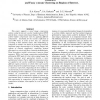Free Online Productivity Tools
i2Speak
i2Symbol
i2OCR
iTex2Img
iWeb2Print
iWeb2Shot
i2Type
iPdf2Split
iPdf2Merge
i2Bopomofo
i2Arabic
i2Style
i2Image
i2PDF
iLatex2Rtf
Sci2ools
EUROMICRO
2000
IEEE
2000
IEEE
Efficient Image Compression of Medical Images Using the Wavelet Transform and Fuzzy c-means Clustering on Regions of Interest
This paper suggests a novel image compression scheme, using the discrete wavelet transformation (DWT) and the fuzzy c-means clustering technique. The goal is to achieve higher compression rates by applying different compression thresholds for the wavelet coefficients of each DWT band, in terms of how they are clustered according to their absolute values. This methodology is compared to another one based on preserving texturally important image characteristics, by dividing images into regions of textural significance, employing textural descriptors as criteria and fuzzy clustering methodologies. These descriptors include cooccurrence matrices based measures. While rival image compression methodologies utilizing the DWT apply it to the whole original image, the herein presented novel approaches involve a more sophisticated scheme. That is, different compression ratios are applied to the wavelet coefficients belonging in the different regions of interest, in which either each wavelet dom...
EUROMICRO 2000 | Image Compression | Image Compression Scheme | Software Engineering | Wavelet Coefficients |
| Added | 31 Jul 2010 |
| Updated | 31 Jul 2010 |
| Type | Conference |
| Year | 2000 |
| Where | EUROMICRO |
| Authors | Dimitris A. Karras, S. A. Karkanis, Dimitrios E. Maroulis |
Comments (0)

